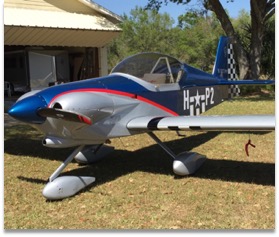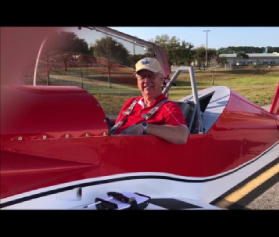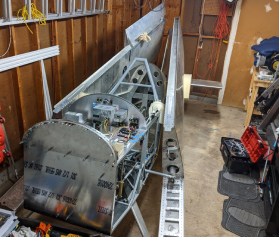The following is a brief summary of my second flight in the Panther.
It occurred on 4/27/2013 at Haller airpark. Departure time was 1325 and lasted for 45 minutes. Winds were estimated to be a right crosswind at 14 mph and temperature in the high 70’s. Fuel load was 20 gallons.
Departure was made with the first notch of flaps with an estimated 20% reduction in takeoff distance. The aircraft lifted off at a noticeable lower speed with little, or no forward stick. Rudder control was strong and positive during the takeoff.
A 90 MPH climb was established and a 10% power reduction was made at 500 feet AGL. A climb over the airport was complete to 6500 feet ranging in airspeed from 110 to 90 MPH. The climb took 10 minutes to reach 6500 feet. The majority of the sortie was accomplished at or above 5000 AGL to explore the low speed envelope.
Multiple series of stalls, accelerated stalls and spins were completed. Deep aft stick stalls were entered and held for up to 30 seconds. With full back stick the aircraft could be sustained in semi level flight with large deflections of aileron and rudder. Sink rate was around 1600 feet per minute with no tendency to have excessive wing drop. Recovery was fast with only a slight release of back pressure.
A series of high G turns were completed to test the accelerated stall characteristics. An entry airspeed of 130 MPH with a 70+ degree bank was initiated with a steed increase of back pressure to 2.7 Gs. The aircraft had very little indication of buffet onset with a rumbling in the aft section of the fuselage. The stall occurred with a significant fuselage rumble and a top wing drop of about 40 degrees. This indication was seen for both right and left turns with acceleration forces up to 3 Gs. The recovery roll rate could be stopped with rudder and the recovery was quick and smooth with a slight release in back pressure. Nose high and low attitudes saw the same general results.
A series of spins were completed with starting attitudes of nose level to 40-50 degrees nose high. Both left and right entries with power on and off. The nose high entry did see a slight increase in the tendency for the aircraft to enter a spin and generally the spin developed with one to 1 1/2 turns. The aircraft resisted spin entry especially from a lower pitch angle. Spins to the right saw a marked tendency for the aircraft to resist spin entry. It was slow to develop and generally took more than one turn to develop. Spins to the right and left for up to 3 turns were completed. In all case the spin could be broken with opposite rudder and forward stick. The recovery occurred within a half turn and was positive with a significant nose low attitude. Recovery with a control release method was accomplished and in every instant the recovery was positive and only slightly slower than the positive control method. Spinning attitude was generally 50-60 degrees nose low.

Overall the aircraft does resist spins but once in a spin or approaching a spin releasing or using positive anti spin inputs will result in recovery promptly. It was predictable and consistence during all phases of stalls and spins.
A normal landing was completed with maximum slips on final. At 70-80 MPH the rudder was very strong and slips with sink rates up to 1800 FPM were observed. Touchdown was in a wheel landing attitude at 60 MPH and the landing roll out was well controlled. During the transition to the three point attitude the rudder appeared to lose a small amount of authority, but this could have been a result to the right crosswind. Further examination will made during my next sortie.
Overall the airplane is a well-mannered craft with predictable results for control inputs. Its harmony of controls, easy breakout forces make it light and responsive. Overall a fun airplane to fly.
– Bob Woolley
Panther Sport Beta Builder








